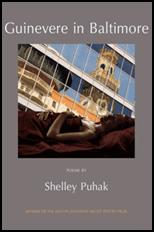|
 
A Twist in the Triangle: Shelley Puhak’s Guinevere in Baltimore
Guinevere in Baltimore
Shelley Puhak
The Waywiser Press
© 2013
ISBN: 978-0-615-31930-8
99 pages
Triangle, tryst, tragedy. Shelley Puhak weaves a city and its inhabitants into a montage of modern American life in Guinevere in Baltimore. While reinventing an ancient love triangle with a new twist is not easy, Puhak interprets Camelot through the lives of 20th century Americans in her second full-length poetry collection. Her sharp lines, internal space, and imagery conjure a breathtaking love story. Her readers do not need to know about Arthur, Guinevere, and Lancelot to enjoy the volume. The poet’s contemporary tale of betrayal, romance, and intrigue highlights the timelessness of desire, materialism, and lust, and their inevitable failure to satisfy us.
Guinevere in Baltimore is both enjoyable to read and a wonderful example of how to construct a book to reflect the guilt, shame, and secrecy of adultery. While the story is historic in nature, the modern city provides the backdrop, with its towers and forts, highways and bridges. There is even a Guinevere Court and King Arthur Circle near Baltimore’s Nottingham Park, bordered by I-95, north of The Beltway.
Puhak opens with “On Having Sex, Grief Stricken,” amid a witchlike menagerie of creatures as she summons the lovers. Inanimate objects possess intelligence of their own, and Guinevere and Lancelot are “. . . stunned our bodies / can still screw / together, the threads / can catch: what has / steeled in you winding / up into my wooden.” There is something primal and sinister in their union, the nature of their intercourse, as if they suddenly find themselves lying in the hotel bed, compelled against their will to couple and, afterwards, unable to separate.
Puhak gives her readers room to breathe, dividing the book into 17 sets of three-poem sections. She provides wide avenues of internal space, similar to an architect designing a city. Each character not only speaks in a distinctive voice, but their separate poems are constructed to reflect this individuality: Lancelot talks in couplets; Guinevere utters tercets with the middle lines indented; Arthur speaks through tercets flush against the left margin. Lancelot is single-minded, while Guinevere is tormented by her affair. Arthur, on the other hand, is resigned to the fact of his wife’s infidelity and his subordinate’s betrayal.
The volume addresses social and political issues, including The Debt Ceiling, Hurricane Agnes, and laptop computers. However, beneath this modern surface lurks parasite-induced insanity. Puhak writes in “Guinevere, Fancying Herself a Wanton Microbiologist:”
This mouse.
The protozoa lost in its
mouth (how? how should I know?)
would rather live in the gut of a cat.
So it convinces the mouse to saunter
right up to a cat. Snap.
In modern Camelot, the parasitic influences include lovers, materialism, and the desire to possess. Arthur toys with Lancelot in “Arthur, Screwing with Lancelot in the Starbucks Line,” “Lance, I fear our Queen has picked up some / parasite.”
Puhak knits the city’s history into the narrative, comparing the affair to a fire in “Letter to an Old Flame,” stating, “What might we make of the embers.” The next poems, however, address a series of holocausts which swept the city in 1904 and 1949. “The Great Fire of Baltimore, 1904” bolts haphazardly across the page like a growing inferno. “The Lexington Market Fire, 1949,” however, assumes the tercet construct associated with King Arthur, indicating behind the monarch’s calm façade is concealed ferocity.
After these disasters, Puhak floods the poems with water, soaking the city in “On Hurricane Agnes:”
. . . We’re already underwater,
as is our mortgage, and though we’re strong
enough swimmers, it was not the waters
but what had seeped back in . . .
In the next piece, Guinevere is reduced to her essence, “not / ashes to ashes but down to / the liquid in which we’re conceived.” The very force used to fight fires now threatens the city and lovers with its own destructive fury. There is no escaping the effects, the dangers, of the affair. Eventually, as shown in “Guinevere to Lancelot in Role-Play: H.D. and Pound,” both fire and flood inhabit them both.
Barbara Goldberg, in her 1986 volume Berta Broadfoot and Pepin the Short, explores the mystery of a medieval romance as well. The main difference between the two books is that Puhak’s love triangle involves two men, whereas Goldberg’s fairy tale includes two women. Berta Broadfoot ends on a note of hope. The king searches for his wife after separating himself from the treacherous Aliste and her scheming mother. “I have given the order to search / each hectare of Le Mans,” Pepin declares. Conversely, Puhak begins her last set of poems with a convergence of the characters, not a separation. In “Snow White and the Seven Satellites,” she forms a sort of triptych of couplets, tercets, and modified tercets through which a bitter Arthur, a selfish Lancelot, and a tormented Guinevere express desires and regrets.
Guinevere in Baltimore catalogs both the story of a love triangle and the accompanying city’s history. Puhak removes the veneer from the lovers, the patina from their liaisons, romance from possession. She strips them, not to reveal beauty but humanity, scarred and bent. As Guinevere and Lancelot meet for the final time at Arthur’s grave, they stand in the desolation, observing as they depart,
. . . Among these vegetative beds, no,
beds of vegetation. Next to a doe’s skull,
her eye socket cracked.
References:
Goldberg, Barbara. Berta Broadfoot and Pepin the Short. Washington, DC, The Word Works.1986.
Puhak, Shelley. Guinevere in Baltimore. Baltimore, MD, Waywiser Press. 2013.
--Paul David Adkins
Paul David Adkins lives in New York and works as a counselor. He served in the US Army for 21 years.
Also by Paul David Adkins: Review of Hurricane Party by Alison Pelegrin |
|


